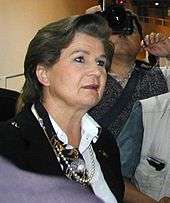Valentina Tereshkova
| Valentina Tereshkova | |
|---|---|
|
Tereshkova in 1969  | |
| Soviet cosmonaut | |
| Nationality |
Soviet Russian |
| Born |
6 March 1937 Bolshoye Maslennikovo, Tutayevsky District, Yaroslavl Oblast, Russian SFSR, Soviet Union |
Other names | Valentina Vladimirovna Tereshkova |
Other occupation | Pilot |
| Rank |
|
Time in space | 2 days, 23hrs, and 12mins |
| Selection | Female Group |
| Missions | Vostok 6 |
Mission insignia |
|
| Awards |
|
Valentina Vladimirovna Tereshkova (Russian: Валенти́на Влади́мировна Терешко́ва; IPA: [vɐlʲɪnʲˈtʲinə vlɐˈdʲimʲɪrəvnə tʲɪrʲɪʂˈkovə]; born 6 March 1937) is a retired Russian cosmonaut and politician. She is the first woman to have flown in space, having been selected from more than four hundred applicants and five finalists to pilot Vostok 6 on 16 June 1963. She completed 48 orbits of the Earth in her three days in space
In order to join the Cosmonaut Corps, Tereshkova was honorarily inducted into the Soviet Air Force and thus she also became the first civilian to fly in space.[1]
Before her recruitment as a cosmonaut, Tereshkova was a textile-factory assembly worker and an amateur skydiver. After the dissolution of the first group of female cosmonauts in 1969, she became a prominent member of the Communist Party of the Soviet Union, holding various political offices. She remained politically active following the collapse of the Soviet Union and is still regarded as a hero in post-Soviet Russia.
In 2013, she offered to go on a one-way trip to Mars if the opportunity arose.[2] At the opening ceremony of the 2014 Winter Olympics, she was a carrier of the Olympic flag.
Early life
Tereshkova was born in the village of Maslennikovo in Tutayevsky District, Yaroslavl Oblast, in central Russia. Her parents had migrated from Belarus.[3] Tereshkova's father was a tractor driver and her mother worked in a textile plant. Tereshkova went to school in 1945 at the age of eight, but left school in 1953 and continued her education by correspondence courses.[4] She became interested in parachuting from a young age, and trained in skydiving at the local Aeroclub, making her first jump at age 22 on 21 May 1959; at the time, she was employed as a textile worker in a local factory. It was her expertise in skydiving that led to her selection as a cosmonaut. In 1961 she became the secretary of the local Komsomol (Young Communist League) and later joined the Communist Party of the Soviet Union.
Career in the Soviet space program

After the flight of Yuri Gagarin in 1961, Sergey Korolyov, the chief Soviet rocket engineer, came up with the idea of putting a woman in space. On 16 February 1962, Valentina Tereshkova was selected to join the female cosmonaut corps. Out of more than four hundred applicants, five were selected: Tatyana Kuznetsova, Irina Solovyova, Zhanna Yorkina, Valentina Ponomaryova, and Tereshkova. Qualifications included that they be parachutists under 30 years of age, under 170 cm (5 feet 7 inches) tall, and under 70 kg (154 lbs.) in weight.[5]
Tereshkova was considered a particularly worthy candidate, partly due to her "proletarian" background, and because her father, tank leader sergeant Vladimir Tereshkov, was a war hero.[6] He died in the Finnish Winter War during World War II in the Lemetti area in Finnish Karelia when Tereshkova was two years old. After her mission she was asked how the Soviet Union should thank her for her service to the country. Tereshkova asked that the government search for, and publish, the location where her father was killed in action. This was done, and a monument now stands at the site in Lemetti—now on the Russian side of the border. Tereshkova has since visited Finland several times.
Training included weightless flights, isolation tests, centrifuge tests, rocket theory, spacecraft engineering, 120 parachute jumps and pilot training in MiG-15UTI jet fighters. The group spent several months in intensive training, concluding with examinations in November 1962, after which four remaining candidates were commissioned Junior Lieutenants in the Soviet Air Force. Tereshkova, Solovyova and Ponomaryova were the leading candidates, and a joint mission profile was developed that would see two women launched into space, on solo Vostok flights on consecutive days in March or April 1963.[7]

Originally it was intended that Tereshkova would launch first in Vostok 5 while Ponomaryova would follow her into orbit in Vostok 6. However, this flight plan was altered in March 1963. Vostok 5 would now carry a male cosmonaut Valery Bykovsky flying the joint mission with a woman aboard Vostok 6 in June 1963. The State Space Commission nominated Tereshkova to pilot Vostok 6 at their meeting on 21 May and this was confirmed by Nikita Khrushchev himself.[8] Tereshkova was exactly ten years younger than the youngest Mercury Seven astronaut, Gordon Cooper.
After watching the successful launch of Vostok 5 on 14 June, Tereshkova began final preparations for her own flight. She was 26 at the time. On the morning of 16 June 1963, Tereshkova and her back-up Solovyova were both dressed in spacesuits and taken to the launch pad by bus. After completing her communication and life support checks, she was sealed inside the Vostok. After a two-hour countdown, Vostok 6 launched faultlessly, and Tereshkova became the first woman in space.[9] Her call sign in this flight was Chaika (English: Seagull; Russian: Ча́йка), later commemorated as the name of an asteroid, 1671 Chaika.[10]
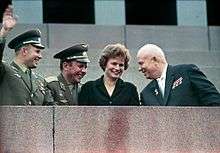
Although Tereshkova experienced nausea and physical discomfort for much of the flight,[11] she orbited the earth 48 times and spent almost three days in space. With a single flight, she logged more flight time than the combined times of all American astronauts who had flown before that date.[12] Tereshkova also maintained a flight log and took photographs of the horizon, which were later used to identify aerosol layers within the atmosphere.[13]
Vostok 6 was the final Vostok flight and was launched two days after Vostok 5 which carried Valery Bykovsky into a similar orbit for five days, landing three hours after Tereshkova. The two vessels approached each other within 5 kilometers (3.1 mi) at one point, and Tereshkova communicated with Bykovsky and with Khrushchev by radio.
Even though there were plans for further flights by women, it took 19 years until the second woman, Svetlana Savitskaya, flew into space. None of the other four in Tereshkova's early group flew, and, in October 1969, the pioneering female cosmonaut group was dissolved.[7]
Education

After her flight, Tereshkova studied at the Zhukovsky Air Force Academy and graduated with distinction as a cosmonaut engineer. In 1977 she earned a doctorate in engineering.
Prominence in Soviet politics
Due to her prominence, Tereshkova was chosen for several political positions: from 1966 to 1974 she was a member of the Supreme Soviet of the Soviet Union, from 1974 to 1989 a member of the Presidium of the Supreme Soviet, and from 1969 to 1991 she was in the Central Committee of the Communist Party. In 1997, she was retired from the Russian Air Force and the cosmonaut corps by presidential order.
Beyond her recognized political offices within the Soviet Union, Tereshkova also became a well known representative of the Soviet Union abroad. She was made a member of the World Peace Council in 1966, a member of the Yaroslavl Soviet in 1967, a member of the Supreme Soviet of the Soviet Union in 1966–1970 and 1970–1974, and was elected to the Presidium of the Supreme Soviet in 1974. She was also the Soviet representative to the UN Conference for the International Women's Year in Mexico City in 1975. She also led the Soviet delegation to the World Conference on Women in Copenhagen and played a critical role in shaping the socialist women's global agenda for peace.[14] She attained the rank of deputy to the Supreme Soviet, membership of the Communist Party of the Soviet Union Central Committee, Vice President of the International Woman’s Democratic Federation and President of the Soviet-Algerian Friendship Society.
She was decorated with the Hero of the Soviet Union medal, the USSR's highest award. She was also awarded the Order of Lenin, Order of the October Revolution, numerous other medals, and foreign orders including the Karl Marx Order, United Nations Gold Medal of Peace and the Simba International Women’s Movement Award. She was also bestowed a title of the Hero of Socialist Labor of Czechoslovakia, Hero of Labor of Vietnam, and Hero of Mongolia. In 1990 she received an honorary doctorate from the University of Edinburgh. Tereshkova crater on the far side of the Moon was named after her.
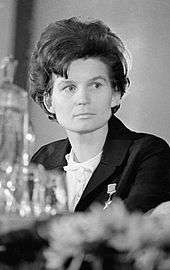
After the collapse of the Soviet Union, Tereshkova lost her political office but none of her prestige. To this day, she is revered as a hero, and to some her importance in Russian space history is only surpassed by Yuri Gagarin and Alexey Leonov. In 2011, she was elected to the State Duma, the lower house of the Russian legislature, where she continues to serve.[15]
Tereshkova's life and spaceflight were first examined (in the west) in the 1975 book: It Is I, Sea Gull; Valentina Tereshkova, the first woman in space by Mitchel R. Sharpe[16] and then again in greater detail of her life and spaceflight in the 2007 book Into That Silent Sea by Colin Burgess and Francis French, including interviews with Tereshkova and her colleagues.
Tereshkova was invited to Prime Minister Vladimir Putin's residence in Novo-Ogaryovo for the celebration of her 70th birthday. While there she said that she would like to fly to Mars, even if it meant that it was a one way trip.[17]
On 5 April 2008, she became a torchbearer of the 2008 Summer Olympics torch relay in Saint Petersburg, Russia.[18]
She received the Eduard Rhein Ring of Honor from the German Eduard Rhein Foundation in 2007.[19][20]
Personal life
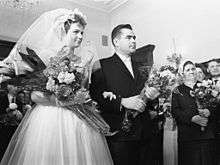
Tereschkova married Andriyan Nikolayev on 3 November 1963 at the Moscow Wedding Palace with Khrushchev himself presiding at the wedding party together with top government and space programme leaders.[21]
On 8 June 1964, she gave birth to their daughter Elena Andrianovna Nikolaeva-Tereshkova,[22] who became a doctor and was the first person to have both a mother and father who had travelled into space. She and Nikolayev divorced in 1982. Nikolayev died in 2004. Her second husband, the orthopaedist Yuliy G. Shaposhnikov, died in 1999.
Honours and awards


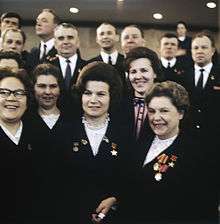
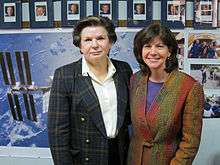

- Russian
- Order of Merit for the Fatherland;
- 2nd class (6 March 2007) – for outstanding contribution to the development of domestic space
- 3rd class (6 March 1997) – for services to the state and the great personal contribution to the development of domestic space
- Order of Alexander Nevsky (2013)[23]
- Order of Honour (10 June 2003) – for outstanding contribution to the development and strengthening of international scientific, cultural and social ties
- Order of Friendship (12 April 2011) – for outstanding contribution to the development of national manned space flight and long-term fruitful public activity
- Russian Federation State Prize for outstanding achievements in the field of humanitarian action in 2008 (4 June 2009)
- Certificates of appreciation from the Government of the Russian Federation;
- 16 June 2008, – for long-term fruitful state and public activities, considerable personal contribution to the development of manned space flight and in connection with the 45th anniversary of spaceflight
- 12 June 2003, – for large contribution to the development of manned space flight
- 3 March 1997, – for the contribution to the development of space, the strengthening of international scientific and cultural ties and years of diligent work
- Soviet
- Honoured Master of Sport (19 June 1963)
- Hero of the Soviet Union (22 June 1963)
- Order of Lenin (22 June 1963; 6 May 1981) – for making progress on the development and strengthening of ties with the progressive community and peace-loving forces of foreign countries
- Order of the October Revolution (1 December 1971)
- Order of the Red Banner of Labour (5 March 1987) – for social activities
- Order of the Friendship of Peoples
- Pilot-Cosmonaut of the Soviet Union
- Other awards – Warsaw Pact
- "Gold Star" Hero of Socialist Labour (Czechoslovakia) (August 1963)
- "Gold Star" Hero of Socialist Labour (Bulgaria) (Bulgaria, 9 September 1963)
- Order of Georgi Dimitrov (Bulgaria, 9 September 1963)
- Order of Karl Marx (October 1963, East Germany)
- Medal of Becker (October 1963, East Germany)
- Cross of Grunwald, 1st class (October 1963, Poland)
- Order of the National Flag with diamonds (Hungary, April 1965)
- Order "For Achievements in Science" (Romania, 17 November 1973)
- Medal "For Strengthening Brotherhood in Arms" (Bulgaria, 1976)
- Order of Klement Gottwald (Czechoslovakia)
- Other awards
- Order of the Star of Nepal, 1st class (November 1963)
- Order of the Star of the Republic of Indonesia, 2nd class (November 1963)
- Order of the Volta (Ghana, January 1964)
- "Gold Soyombo" Hero of Labour (Mongolia)
- Order of Sukhbaatar (Mongolia, May 1965)
- Order of the Enlightenment (Afghanistan, August 1969)
- Order of Planets (Jordan, December 1969)
- Order of the Nile (Egypt, January 1971)
- "Gold Star" Hero of Labour (Vietnam) (October 1971)
- Order of Bernardo O'Higgins (Chile, March 1972)
- Order of the Yugoslav Flag with sash (November 1972)
- Grand Cross of the Order of the Sun (Peru, 1974)
- Order of Playa Girón (Cuba, 1974)
- Order of Anne Betancourt (Cuba, 1974)
- Order of Duke Branimir, with sash (Croatia, 17 February 2003)
- Scientific, social and religious organizations
- Gold Medal, Tsiolkovsky Academy of Sciences of the USSR
- Gold Medal of the British Society for interplanetary communications "For achievements in space exploration" (February 1964)
- Gold Medal of the "Cosmos" (FAI)
- Award Galambera Astronautics
- Gold Medal of Peace Joliot-Curie (France, 1964)
- Order "Wind Rose" International Committee of the National Aeronautics and Space Missions
- "Golden mimosa" of the Italian Union of Women (1963)
- Sign of the Komsomol "For active in the League" (1963)
- Gold Medal Exhibition of Economic Achievements (28 June 1963)
- Honour of DOSAAF (1 July 1963)
- Order of St. Euphrosyne, Grand Duchess of Moscow, 2nd class (2008)
- Honorary citizenships
Kaluga, Yaroslavl (Russia), Karaganda, Baikonur (Leninsk, Kazakhstan, 1977), Gyumri (Leninakan, Armenia, 1965), Vitebsk (Belarus, 1975), Montreux (Switzerland), Drancy (France), Montgomery (UK), Polizzi Generosa (Italy), Darkhan (Mongolia, 1965), Sofia, Burgas, Petrich, Stara Zagora, Pleven, Varna (Bulgaria, 1963), Bratislava (Slovakia, 1963)
- Recognition
Various locations and monuments have been named after Valentina Tereshkova:
- A lunar crater, Tereshkova
- A minor planet 1671 Chaika
- Yalta embankment
- Many streets in Vitebsk, Volokolamsk, Grodno, Irkutsk, Ishimbay, Kemerovo, Klin, Korolyov, Lipetsk, Mytishchi, Ardatov, Novosibirsk (Akademgorodok), Novocheboksarsk, Odessa, Orenburg, Yaroslavl, Krasnoyarsk, Penza, Gudermes (Chechen Republic)
- A square in Tver
- School number 32 in Yaroslavl, where she studied
- Museum of Tereshkova "Cosmos" near her native village
- Monument in Bayevsky District of Altai Territory, Siberia, close to her landing place of 53°N, 80°E.[24]
- "Greatest woman of 20th century"
- Cosmonaut monument in Moscow
- Monument planned at Tereshkova's birthplace in Yaroslavl
- Yaroslavl Planetarium (7 April 2011)
In popular culture
A representation of Valentina Tereshkova is included in Kerbal Space Program, named "Valentina Kerman"[25] who is the first female 'kerbonaut' in the game; she also has the 'badass' personality type, meaning the character responds with awe or pleasure even in extremely dangerous situations.
In 1997, London-based electronic pop group Komputer released a song entitled Valentina which gives a more-or-less direct account of her career as a cosmonaut. It was released as a single and appears on their album The World of Tomorrow. The band Public Service Broadcasting has a song entitled Valentina on their 2015 album The Race for Space in tribute to her. In the same year, Findlay Napier's album VIP: Very Interesting Persons included a song Valentina, written in her honour by Napier and Boo Hewerdine.
In season three of Orange is the New Black, Red describes Tereshkova as her hero, and notes her focus in wanting to travel to Mars, despite being in her seventies.
In 2015, a short film entitled Valentina's Dream was released by Meat Bingo Productions. The film stars Rebecca Front as Tereshkova and is based on an interview by the former cosmonaut where she expressed a desire to journey to Mars.
The 2007 video game Mass Effect included a fictional star system named for Tereshkova.
Streets in Ukraine that did bear Tereshkova's name have been renamed due to the country's 2015 decommunization law.[26]
See also
References
- ↑ "Valentina Vladimirovna Tereshkova". Yaroslavl Region. 2016. Retrieved 3 April 2016.
- ↑ "First female astronaut Valentina Tereshkova wants one-way Mars ticket". News.com.au. 9 June 2013. Retrieved 3 April 2016.
- ↑ "Першая жанчына‑касманаўт ў дзяцінстве гаварыла па‑беларуску" [The first woman in space spoke Belarusian as a child]. Nasha Niva (in Belarusian). 24 April 2009. Retrieved 3 April 2016.
- ↑ "Valentina Tereshkova". StarChild: NASA Goddard Space Flight Center. 2016. Retrieved 3 April 2016.
- ↑ Ghosh, Pallab (17 September 2015). "Valentina Tereshkova: USSR was 'worried' about women in space". BBC News. Retrieved 3 April 2016.
- ↑ Tereshkova, Valentina (2015). Valentina Tereshkova, The First Lady of Space: In Her Own Words. SpaceHistory101.com Press. ISBN 978-1887022996.
- 1 2 Sever, Megan (June 2014). "June 16, 1963 & June 18, 1983: Valentina Tereshkova and Sally Ride Become First and Third Women in Space". Earth. 59 (6): 60–61. Retrieved 3 April 2016.
- ↑ Burgis, Colin; Vis, Bert (2015). Interkosmos: The Eastern Bloc's Early Space Program. Springer Paxis Books. ISBN 978-3319241616.
- ↑ Knapton, Sarah (17 September 2015). "Russia forgot to send toothbrush with first woman in space". The Daily Telegraph. Retrieved 3 April 2016.
- ↑ Knight, Kelly (June 2003). "Earth calling Seagull". Astronomy. 31 (6): 30.
- ↑ "Валентина Терешкова: чьей воле покорялась женщина, покорившая космос" [Valentina Tereshkova: the Woman who Conquered Space]. RIA Novosti (in Russian). 16 June 2006. Retrieved 3 April 2016.
- ↑ Kennedy, Maev (17 September 2015). "First woman in space recalls mission's teething troubles". The Guardian. Retrieved 3 April 2016.
- ↑ Tereshkova, Valentina (4 January 1964). "Three days in outer space". The Saturday Evening Post. 237 (1): 62–63.
- ↑ Ghodsee, Kristen (Winter 2012). "Rethinking State Socialist Mass Women's Organizations: The Committee of the Bulgarian Women's Movement and the United Nations Decade for Women, 1975-1985" (PDF). Journal of Women's History. 24 (4): 49–73.
- ↑ "Терешкова Валентина Владимировна" [Tereshkova, Valentina Vladimirovna]. The State Duma of the Federal Assembly of the Russian Federation. 2016. Retrieved 3 April 2016.
- ↑ Sharpe, Mitchell R. (1975). "It is I, Sea gull;": Valentina Tereshkova, first woman in space. Crowell. ISBN 978-0-690-00646-9.
- ↑ "First woman in space dreams of flying to Mars". Reuters. 6 March 2007. Retrieved 26 May 2008.
- ↑ "Олимпийский огонь понесут Друзь, Фрейндлих и Плющенко". Komsomolskaya Pravda (in Russian). 16 October 2012. Retrieved 4 March 2013.
- ↑ "The Eduard Rhein Ring of Honor Recipients". Eduard Rhein Foundation. Retrieved 5 February 2011.
- ↑ "Ring of Honor 2007 – Dr. techn. Dr.h.c.mult. Valentina V. Tereschkova". Eduard Rhein Foundation (in German). Retrieved 5 February 2011.
- ↑ Eidelman, Tamara (2013). "A Cosmic Wedding". Russian Life. 56 (6): 22–25.
- ↑ Feldman, Heather (2003). Valentina Tereshkova: The First Woman in Space. Rosen Publishing Group. ISBN 0-8239-6246-6.
- ↑ "The Japan News". the-japan-news.com.
- ↑ Rosen, Rebecca J. (16 June 2013). "The Remote Siberian Monument to the First Woman in Space, Who Launched 50 Years Ago Today". The Atlantic. Retrieved 3 April 2016.
- ↑ "Valentina Kerman". Kerbal Space Program Wiki. 2016. Retrieved 3 April 2016.
- ↑ (Ukrainian) Muscovite renamed all the streets Valentina Tereshkova, Ukrayinska Pravda (12 April 2016)
Further reading
- Bill O’Neil, "Whatever became of Valentina Tereshkova?" New Scientist 8/14/93, Vol. 139, Issue 1886p. 21.
- A. Lothian, Valentina: The First Woman in Space, The Pentland Press, 1993, ISBN 978-1858210643.
- Tamara Eidelman, "The First Woman in Space," Russian Life. May/Jun 2008, Vol. 51, Issue 3, p. 19-21.
- Tamara Eidelman, "The Extraordinary Destiny of an ‘Ordinary’ Woman," Russian Life. May/June 2003, Vol. 46, Issue 3, p.19.
- Daniel Gauthier, "Valentina Vladimirovna Tereshkova." Ad Astra. Jul/Aug 1991, Vol. 3, Issue 6, p. 29.
- Robert Griswold, ""Russian Blonde in Space": Soviet Women in the American Imagination, 1950-1965." Journal of Social History. Summer 2012, Vol. 45, Issue 4, p.881-907.
- Laira Woodmansee, "Two who dared," Ad Astra. Summer 2005, Vol. 17, Issue 2, p. 48-48.
- "First woman in space" at History.com
- Valentina Tereshkova, The First Lady of Space: In Her Own Words, spacebusiness.com, October 2015
External links
| Wikimedia Commons has media related to Valentina Tereshkova. |
| Wikimedia Commons has media related to Commons:RIA Novosti/Tereshkova. |
- BBC: Tereshkova received the Greatest Woman of the Century Award
- RSC Energia Biography of Tereschkova including a comprehensive list of awards and honors.
- Biography of Tereshkova
- Valentina Vladimirovna Tereshkova: The First Woman in Space
- Concept album inspired by Tereshkova's pioneering achievements, by Kurt Swinghammer
- "Testing of rocket and space technology - the business of my life" Events and facts - A.I. Ostashev, Korolyov, 2001.;
- "Bank of the Universe" - edited by Boltenko A. C., Kiev, 2014., publishing house "Phoenix", ISBN 978-966-136-169-9
- A.I. Ostashev, Sergey Pavlovich Korolyov - The Genius of the 20th Century — 2010 M. of Public Educational Institution of Higher Professional Training MGUL ISBN 978-5-8135-0510-2.
- "S. P. Korolev. Encyclopedia of life and creativity" - edited by C. A. Lopota, RSC Energia. S. P. Korolev, 2014 ISBN 978-5-906674-04-3
- The official website of the city administration Baikonur - Honorary citizens of Baikonur

